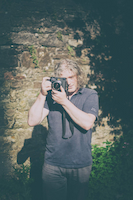Being born and brought up in Ireland one is surrounded by references to the chief of the island's three patron saints, Saint Patrick. Travelling through counties Antrim, Down, Armagh there are references to this mysterious and legendary figure everywhere. The other two patron saints of Ireland are St. Brigid and St. Columba also known as Columcille - but don't get Columba confused with Columbanus.
The unmistakable sight of Slemish sitting lonely just off the Antrim plateau, looking like an upturned basin this mountain is comprised of the central remnant of an extinct volcano from the days when this part of Ireland was the centre of a large volcanic complex.

Slemish was the site of Saint Patrick's captivity in Ireland after being kidnapped by Irish raiders in the fifth century. He was forced to tend sheep here for many years on this mountain top until he escaped back to Britain where he became a cleric.
Returning to Ireland as a bishop he set about converting the pagan Irish to Christianity, tending to spend most of his time with the nobles in Irish society.

He is reputed to have travelled far and wide thoughout Ireland (nearly every townland has a St. Patrick's Well) but there is not much evidence that he ever went to most of the places attributed to him. Most of the key sites associated with him are in the northern counties of Antrim, Armagh and Down, except notably for Dublin's St. Patrick's Cathedral where he baptised some local chieftains, Croagh Patrick in Co. Mayo (below) where he fasted on the barren coastal mountain for 40 days and 40 nights - also said to be the place where he banished snakes from Ireland, and Cashel where he converted the King of Munster.

Of course we know that snakes never made it to Ireland in the first place, as the island was cut off from continental Europe by rising sea levels after the end of the last ice age approximately 10,000 years ago. In fact Ireland has fewer animal species than any European country for this reason.
Armagh, where St. Patrick established his most holy church in Ireland is still today home to the cardinals of the Catholic and Church of Ireland religions in Ireland. For centuries it was known as the City of Saints and Scholars, the importance of Armagh is shown by the fact that Brian Boru, the legendary high king of Ireland killed during the Battle of Clontarf in 1014AD, is buried in the city. My first published book entitled Portrait of Armagh featured lots of the places associated with St. Patrick including the two cathedrals and Navan Fort.
The reason of course as to why Armagh was so important was the nearby Emain Macha, a royal site and the capital of Ulster in pre-Christian Ireland, today it is known as Navan Fort and it is here where he met with local chieftain Daire to acquire land in what is now Armagh, to build his church.

Saint Patrick established his first church in Saul, Co. Down in the year 432AD and is buried in nearby Downpatrick. The story goes that his body was put on a cart pulled by two oxen and they took a wrong turn, stopping at Downpatrick and this is the reason why the saint is not buried in his holy site of Armagh.
Myths, legends and reality all combine to make an entertaining story but it is certainly true that Saint Patrick is one of the best known church saints in the world, with parades and festivals held around the 17th March each year in New York, Chicago, London, Japan, Sydney and Cape Town amongst other places.
Dublin sees thousands of visitors during the festival, many of whom wear those big green hats and shamrocks emblazoned on their faces and attire.
Panoramic Ireland run photography tours and workshops throughout Ireland. If you're visiting Dublin, Mayo or Northern Ireland - any of the places associated with Saint Patrick then contact me to enquire about my personalised one-on-one and small group photography tours.
Happy St. Patrick's Day wherever you are!

